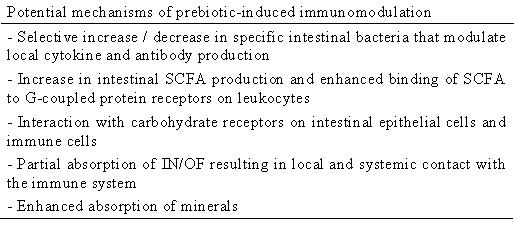Inulin and oligofructose are non-digestible carbohydrates that are present in vegetables, cereals and fruits. They belong to a category of carbohydrates that are constructed of chains of fructose molecules called fuctans. Structurally inulins are linear fructans (10 to 60 fructose molecules long) with terminal α‑D-glucose with (1→2) linkage. Inulins can be enzymatically degraded synthetically in the laboratory or in plants to form shorter chains of fructose molecules of chain length from 1 to 7, called oligofructose. When inulin and oligofructose reach the large intestine during digestion, they are fermented by gut bacteria as a source of food. This causes the growth of bifidobacterium and lactobacilli, which may have health promoting function, including interactions with the immune system of the intestine (table 1). Because they are a source of food for gut bacteria they are sometimes called prebiotics.
Research suggests that inulin and oligofructose and their intestinal breakdown products may interact with gut-associated lymphoid tissue (GALT), and possibly the systemic immune system. By increasing the ratio of bifidobacterium and lactobacilli to other microflora, potential pathogenic bacteria in the intestinal lumen may be reduced, which may then subsequently reduce the levels of inflammatory cytokines and cause the deactivation of various immune signals that respond to pathogens. Importantly, bifidobacteria is associated with increase levels of IgA in the small intestine as has been shown by feeding studies. Short-chain (SCFA) fatty acids are produced by bacterial degradation of dietary fructans, and high concentrations of SCFA in the intestine may increase epithelial cell proliferation throughout the intestinal tract. In addition, SCFA can result in the formation of butyrate which may interact with the GALT to stimulate various aspects of immunity.
Immune cells have carbohydrate receptors and prebiotics may be able to activate some types of these receptors. To stimulate these immune cells outside of the intestinal lumen the prebiotics would need to be absorbed. Research suggests that oligosaccharides from breast milk are partially absorbed intact from the intestinal lumen of infants and certain fructans have been shown to be present in the plasma of rats following ingestion. Dietary inulin and oligofructose may therefore be partially absorbed and directly stimulate both the GALT and components of the immune system such as phagocytic cells, T and B lymphocytes and natural killer cells. In addition, fermentation of prebiotics to SCFA may increase mineral absorption by alteration of caecal pH and by the formation of mineral complexes. Because some minerals are important to immune function (e.g. zinc and selenium) this may have important immune stimulating effects.
Table 1. The effects of inulin and oligofructose on the immune system. SCFA, short-chain fatty acids. In, inulin. OF, oligofructose1.
RdB

